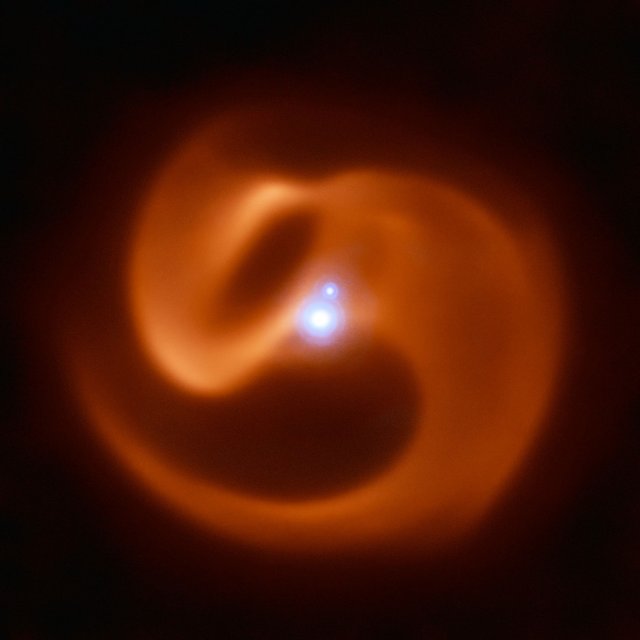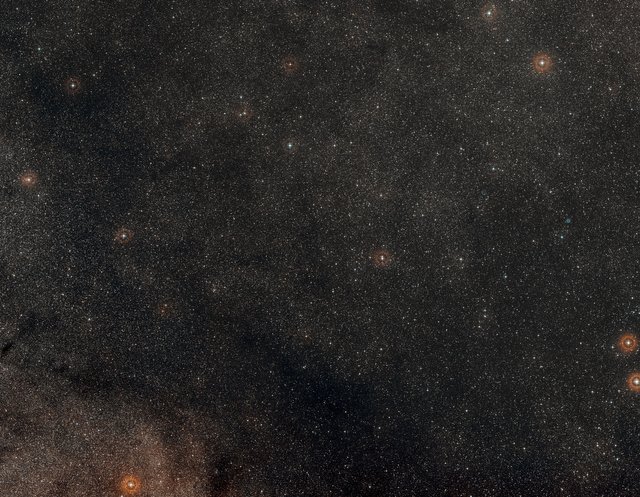ESO Captures Stunning Image of a Newly Discovered Triple Star System

The VISIR instrument on ESO’s VLT captured this stunning image of a newly-discovered massive binary star system. Nicknamed Apep after an ancient Egyptian deity, it could be the first gamma-ray burst progenitor to be found in our galaxy. Apep’s stellar winds have created the dust cloud surrounding the system, which consists of a binary star with a fainter companion. With 2 Wolf-Rayet stars orbiting each other in the binary, the serpentine swirls surrounding Apep are formed by the collision of two sets of powerful stellar winds, which create the spectacular dust plumes seen in the image. The reddish pinwheel in this image is data from the VISIR instrument on ESO’s Very Large Telescope (VLT), and shows the spectacular plumes of dust surrounding Apep. The blue sources at the centre of the image are a triple star system — which consists of a binary star system and a companion single star bound together by gravity. Though only two star-like objects are visible in the image, the lower source is in fact an unresolved binary Wolf-Rayet star. The triple star system was captured by the NACOadaptive optics instrument on the VLT. Credit: ESO/Callingham et al.
The VISIR instrument on ESO’s Very Large Telescope has captured this stunning image of a newly discovered massive triple star system. Nicknamed Apep after an ancient Egyptian deity, this may be the first ever gamma-ray burst progenitor found.
This serpentine swirl, captured by the VISIR instrument on ESO’s Very Large Telescope (VLT), has an explosive future ahead of it; it is a Wolf-Rayet star system, and a likely source of one of the most energetic phenomena in the Universe — a long-duration gamma-ray burst (GRB).
“This is the first such system to be discovered in our own galaxy,” explains Joseph Callingham of the Netherlands Institute for Radio Astronomy (ASTRON), lead author of the study reporting this system. “We never expected to find such a system in our own backyard”.
The system, which comprises a nest of massive stars surrounded by a “pinwheel” of dust, is officially known only by unwieldy catalogue references like 2XMM J160050.7-514245. However, the astronomers chose to give this fascinating object a catchier moniker — “Apep”.
Apep got its nickname for its sinuous shape, reminiscent of a snake coiled around the central stars. Its namesake was an ancient Egyptian deity, a gargantuan serpent embodying chaos — fitting for such a violent system. It was believed that Ra, the Sun god, would battle with Apep every night; prayer and worship ensured Ra’s victory and the return of the Sun.

The image is a colour composite made from exposures from the Digitized Sky Survey 2 (DSS2), and shows the region surrounding 2XMM J160050.7-514245, nicknamed “Apep”. The field of view is approximately 2.4 x 2.0 degrees. Credit: ESO/Digitized Sky Survey 2. Acknowledgment: Davide De Martin
GRBs are among the most powerful explosions in the Universe. Lasting between a few thousandths of a second and a few hours, they can release as much energy as the Sun will output over its entire lifetime. Long-duration GRBs — those which last for longer than 2 seconds — are believed to be caused by the supernova explosions of rapidly-rotating Wolf-Rayet stars.
Some of the most massive stars evolve into Wolf-Rayet stars towards the end of their lives. This stage is short-lived, and Wolf-Rayets survive in this state for only a few hundred thousand years — the blink of an eye in cosmological terms. In that time, they throw out huge amounts of material in the form of a powerful stellar wind, hurling matter outwards at millions of kilometres per hour; Apep’s stellar winds were measured to travel at an astonishing 12 million km/h.
This zoom video starts with a wide view of the Milky Way and ends with a close-up look at the serpentine swirls of dust surrounding a newly-discovered massive binary star system. Nicknamed Apep after an ancient Egyptian deity, it could be the first gamma-ray burst progenitor to be found in our galaxy.
These stellar winds have created the elaborate plumes surrounding the triple star system — which consists of a binary star system and a companion single star bound together by gravity. Though only two star-like objects are visible in the image, the lower source is in fact an unresolved binary Wolf-Rayet star. This binary is responsible for sculpting the serpentine swirls surrounding Apep, which are formed in the wake of the colliding stellar winds from the two Wolf-Rayet stars.
Compared to the extraordinary speed of Apep’s winds, the dust pinwheel itself swirls outwards at a leisurely pace, “crawling” along at less than 2 million km/h. The wild discrepancy between the speed of Apep’s rapid stellar winds and that of the unhurried dust pinwheel is thought to result from one of the stars in the binary launching both a fast and a slow wind — in different directions.
This would imply that the star is undergoing near-critical rotation — that is, rotating so fast that it is nearly ripping itself apart. A Wolf-Rayet star with such rapid rotation is believed to produce a long-duration GRB when its core collapses at the end of its life.
Publication: J. R. Callingham, et al., “Anisotropic winds in Wolf-Rayet binary identify potential gamma-ray burst progenitor,” Nature Astronomy (2018)
Congratulations @tanversaadakash! You received a personal award!
You can view your badges on your Steem Board and compare to others on the Steem Ranking
Vote for @Steemitboard as a witness to get one more award and increased upvotes!